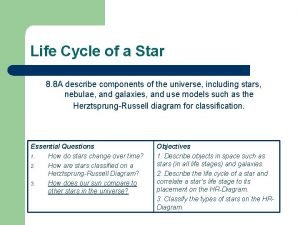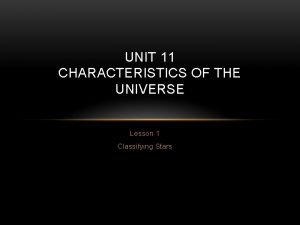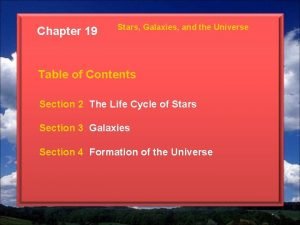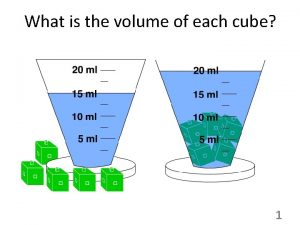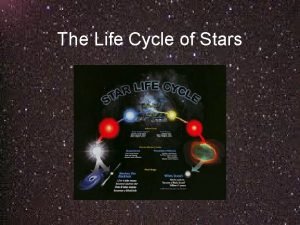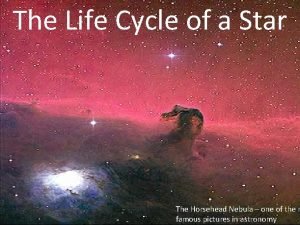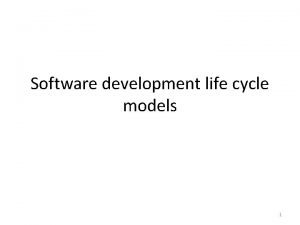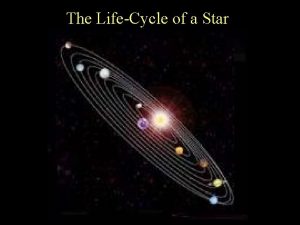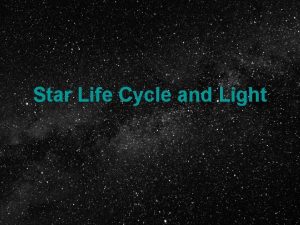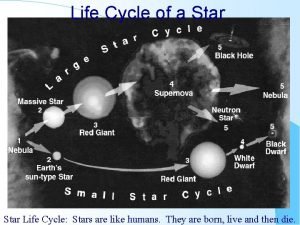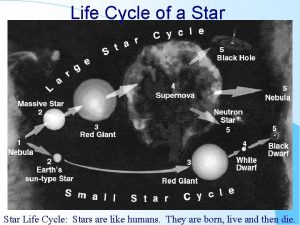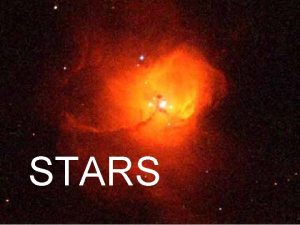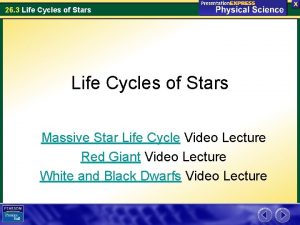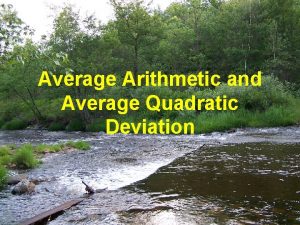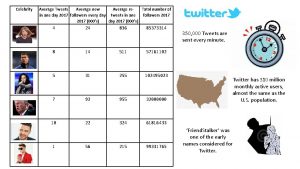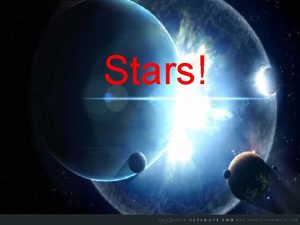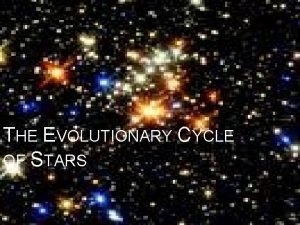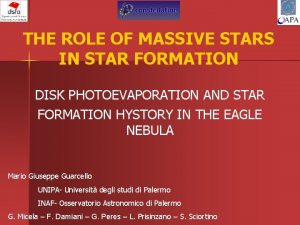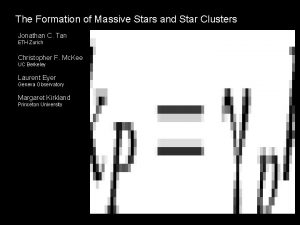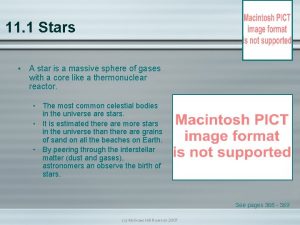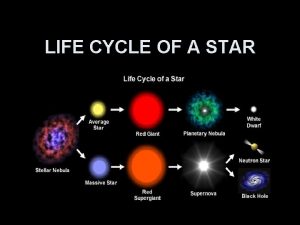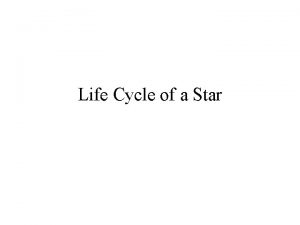Stars Life Cycle of Stars AVERAGE STAR MASSIVE




















- Slides: 20

Stars

Life Cycle of Stars AVERAGE STAR MASSIVE STAR RED SUPERGIANT RED GIANT STELLAR NEBULA NEUTRON STAR PLANETARY NEBULA WHITE DWARF BLACK HOLE SUPERNOVA

Life Cycle of Stars

Hertzsprung-Russell Diagram

What is a star? • The objects that heat and light the planets in a system • A star is a ball of plasma held together by its own gravity – Nuclear reactions (FUSION) occur in stars, fusing lighter elements into heavier elements. (e. g. H He) – Energy from the nuclear reactions is released as electromagnetic radiation

Characteristics of Stars • DISTANCE – Measured in light-years • The distance which a ray of light would travel in one year • About 6, 000, 000 (6 trillion) miles • 186, 000 miles per second

Characteristics of Stars • Magnitude (brightness) – A measure of brightness of celestial objects • Smaller values represent brighter objects than larger values – Apparent magnitude • How bright stars APPEAR to be from Earth – Absolute magnitude (luminosity) • How bright a star actually is

Characteristics of Stars • Temperature & Color – Color and temperature are tied together – Stars are classified by temperature • Decreasing T (bright to dim) • O, B, A, F, G, K, M [Oh Be A Fine Girl, Kiss Me ] • Blue = hot, red = cold (backwards!) http: //www. seasky. org/cosmic/sky 7 a 01. html

Main Sequence Stars • A major grouping of stars that forms a narrow band from the upper left to the lower right when plotted according to luminosity and surface temperature on the Hertzsprung-Russell diagram

Types of Stars Classification Class Temperature Color O 20, 000 - 60, 000 K Blue B 10, 000 – 30, 000 K Blue-white A 7, 500 – 10, 000 K White F 6, 000 – 7, 500 K Yellow-white G 5, 000 – 6, 000 K Yellow K 3, 500 – 5, 000 K Orange M 2, 000 – 3, 500 K Red

http: //www. answers. com/topic/stellar-classification

Life Cycle of Stars http: //hea-www. cfa. harvard. edu/CHAMP/EDUCATION/PUBLIC/ICONS/life_cycles. jpg

Life Cycle of Stars • Stars begin their lives as clouds of dust and gas called NEBULAE • Gravity may cause the nebula to contract • Matter in the gas cloud will begin to condense into a dense region called a PROTOSTAR • The protostar (proto-: beginning) continues to condense and heat up. Eventually, it reaches a critical mass, and nuclear fusion begins. • Begins the main sequence phase of the star • Most of its life is in this phase.

Life Cycle of Stars Life span of a star depends on its size. – The larger the mass, the SHORTER the life span. – A large star’s main sequence may last only a few hundred thousand years – Smaller stars will live on for billions of years because they burn their fuel much more slowly • Eventually, the star's fuel will begin to run out.

Life Cycle of Stars • It will expand into what is known as a red giant • Massive stars will become red supergiants • This phase will last until the star cannot fuse any more elements • At this point the star will collapse

Life Cycle of Stars • Most average stars will blow away their outer atmospheres to form a planetary nebula • Their cores will remain behind and burn as a white dwarf until they cool down into a black dwarf

Life Cycle of Stars • If the star is massive enough, the collapse will trigger a violent explosion known as a supernova • If the remaining mass of the star is about 1. 4 times that of our Sun, it will collapse further to become a neutron star

Life Cycle of Stars • The matter inside the star will be compressed so tightly that its atoms are compacted into a dense shell of neutrons. If the remaining mass of the star is more than about three times that of the Sun, it will collapse so completely that it will literally disappear from the universe. What is left behind is an intense region of gravity called a black hole.

Planet/Star Comparison

Fate of the Sun/Earth
 Life cycle of a low medium mass star
Life cycle of a low medium mass star Life cycle of an average star
Life cycle of an average star Star of wonder star of night star of royal beauty bright
Star of wonder star of night star of royal beauty bright What is the life cycle of a star
What is the life cycle of a star Star life cycle simulation
Star life cycle simulation Life cycle of stars graphic organizer
Life cycle of stars graphic organizer Chapter 19 section 2 the life cycle of stars answer key
Chapter 19 section 2 the life cycle of stars answer key Stellar evolution poster
Stellar evolution poster What are the three major watersheds in virginia
What are the three major watersheds in virginia Protostar phase
Protostar phase Life cycle of a star
Life cycle of a star Star life cycle diagram
Star life cycle diagram Advantages of spiral model
Advantages of spiral model Solar spectrum
Solar spectrum Star lifecycle model
Star lifecycle model What is the life cycle of a star
What is the life cycle of a star Star life cycle from birth to death
Star life cycle from birth to death The life cycle of a star nebular hypothesis
The life cycle of a star nebular hypothesis Star life cycle from birth to death
Star life cycle from birth to death Star life cycle from birth to death
Star life cycle from birth to death High mass star life cycle
High mass star life cycle

